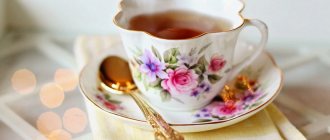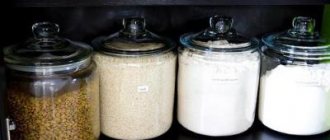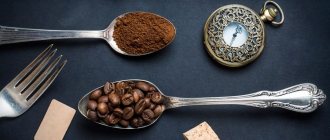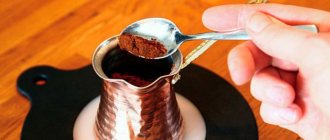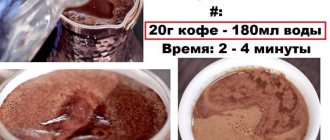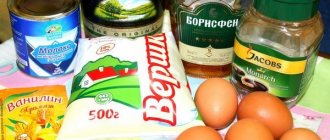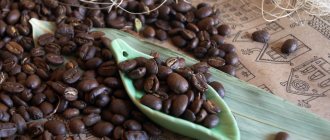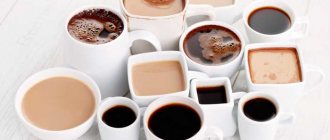There are very interesting recipes in Western sources. Russian-language media and bloggers often like to translate and publish them. And the chefs themselves do not pass by an interesting pudding or baked turkey. It’s just that the ingredients in these recipes are given in measurements that are unusual for us. European and American chefs use completely different measures, where the glasses we are used to are replaced with cups that have a completely different volume.
Since American and English recipes are the most popular among us (it is more convenient to read sources in English), we talk about the measures of weight and volume in them.
American recipes
Cups . We use a glass as a measure for bulk products. The most common glass is faceted and has a volume of about 200 ml. Therefore, when we write “1 cup” in our recipes, it usually means this volume.
American cups are not equal to Russian glasses. They come in different sizes, 230 or 240 ml. The most popular is 240.
An American cup thus holds 240 ml of liquid, water or milk. But bulk products are a different matter; they give different weights in one volume.
How do Russian and metric systems of measures relate? Infographics Read more
Here are the main ones:
Flour - 120 g Sugar - 200 g Powdered sugar - 100 g Starch - 120 g Oat flakes - 90 g Chopped nuts - 150 g Hard cheese - 90 g Condensed milk - 300 g Honey - 340 g
Liquids and volumes:
Ounce (oz), ounce - 29.6 milliliters Gill, US gill - 118 milliliters Pint (pt), pint - 0.47 liters Quart (qt), quart - 2 pints - 0.94 liters Gallon (gal), gallon - 4 quarts - 3.8 liters
There are liquid and regular ounces. A fluid ounce is equal to 29.5 ml, which is rounded to 30 ml for convenience.
Products and weight:
An ounce for measuring weight is equal to 28 grams. 1 pound is 454 grams.
Spoons . Our teaspoon is equal to the American one: 5 ml. A tablespoon is 15 ml, often we mean more: 20 ml.
Sticks . Sometimes in American recipes there is a “stick of butter”. This is a kind of pack, only in our country it weighs 180 g, and the American stick weighs 113 g. As in Russian recipes, there is half a stick, a third, and so on.
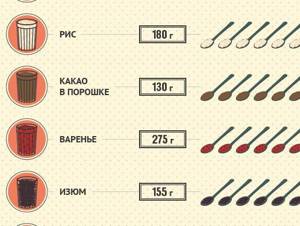
How many grams of different products fit in a faceted glass. Memo Read more
How much is a cup of flour? How to convert American culinary scales.
Those who love to cook and have gastronomic curiosity look for interesting recipes on various resources.
Sometimes these resources, for example, American culinary blogs, use unusual measures of products, which can put an amateur cook in a difficult position, since the result - a tasty and original dish - depends on the correct amount of ingredients.
For example, quite often bulk products such as flour or sugar are measured in cups, and not in glasses or in grams as we are used to. The question immediately arises: which cup?
American culinary cup
The capacity is usually 240 ml. Measuring cups can be purchased at many culinary and hardware stores, often in the form of a set: cup. half a cup, a quarter cup.
If it is not available, you can use any measuring container of the required volume - glass, plastic, ceramic. Important: the recipes do not mention 240 gr. flour, sugar, nuts, chocolate chips, and the amount that fits in a measuring cup.
1 cup of flour - approximately 145 grams of wholemeal premium flour or 135 grams of sifted flour. This weight can vary depending on the type, density and level of grinding of flour.
1 cup of sugar - approximately 195 grams of medium-ground sugar, can also be changed for coarse or fine sugar.
1 cup other foods
V:
milk – 250 gr. vegetable oil – 224 gr. raisins and dried fruits cut into pieces – 165 gr. cocoa powder – 128 gr. medium fat yogurt or sour cream – 245 gr. water – 236 gr. Coarse cane sugar – 100 gr. table salt – 300 gr. nuts, coarse crumbs – 150 gr. breadcrumbs – 150 gr. fresh bread crumbs – 120 gr. grated parmesan cheese – 90 gr.
Self-raising flour
A common component for butter and dessert baked goods. This is just flour with baking powder already added to it; a similar product can be found “now in Russia”, for example, from Pudov. You can add baking powder or regular baking soda yourself when baking.
Stick of butter
In American stores, butter is often sold not only in the usual packs weighing usually 180 grams, but in small cylindrical packages similar to popsicles.
A stick of butter typically weighs 113 g, 1/4 lb, 1/2 measuring cup, 8 tbsp. spoon, half a stick – 55-57 g. respectively.
All these measures are very approximate and are more suitable for undemanding home cooking; measuring products in grams, pounds, ounces, milliliters allows you to get more accurate proportions.
Subscribe to
the channel , be the first to watch recipes for delicious and healthy dishes of modern and historical world cuisine. Help the channel become even more interesting
See other delicious and healthy recipes:
Healthy eating with pleasure
- more than 400 recipes of Russian and world cuisine for every taste and budget.
Source
English recipes
A British cup equals 284 grams. Of course, 4 grams is usually rounded down to zero.
Liquids . Most often in British recipes liquids are measured not in cups, but in ounces, pints and gallons.
1 gallon - 4 quarts - 8 pints - 4.5 l 1 quart - 2 pints - 1.13 l 1 pint - 0.57 l (cf. American pint - 0.47 l) 1 gill - 142.5 ml English fl oz - 28.4 ml
English bottles . Often in recipes you can find the volume “1 bottle of milk”. Keep in mind that this is not a liter. And the British bottle of whiskey is not 0.5 liters.
1 bottle of milk - 946 ml 1 bottle of whiskey - 757 ml 1 bottle of wine - 750 ml (at least here it matches our wine) 1 bottle of champagne - 630 ml 1 wine glass, can be translated as "glass", - 2 fluid ounces - 56 .8 ml According to other sources, 1 wine glass is equal to 5 tbsp. l. - or ½ gill - 71 ml
American and English systems of measures in cooking
The menus and recipes of American/English diets use their own, non-metric system of measures.
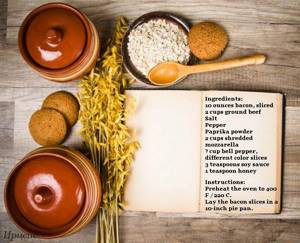
In English cookbooks, the traditional measure of volume is 1 cup. Cup is a cup.
How many grams are in 1 cup? The volumes of cups are not the same in different cuisines. As a measure of volume, cups are not defined as strictly as spoons. The volume of the cup can vary from 200 to 250 milliliters. If in Australia, Canada, New Zealand a cup can be safely equated to a more familiar glass (250 ml), then in the USA the volume of a cup will be equal to 237 ml, and in the UK, where the so-called imperial system of weights and measures is in use, one imperial cup (imperial cup) is already 284 ml. A metric cup is 250 milliliters, and an American cup is slightly smaller, approximately 236.6 milliliters. In American dietetics, the volume of a cup is 240 milliliters. In Japan, cups are even smaller - only 200 milliliters.

Let's see how many grams of various bulk products can be measured in an American cup.
American measuring cup
- 1/4 cup - 60ml
- 1/3 cup – 75ml
- 1/2 cup – 125ml
- 2/3 cup - 150ml
- 3/4 cup - 175ml
- 1 cup – 250ml
It should be noted that most measuring cups come in three sizes - 230ml, 240ml and 250ml. Apparently that’s why the volume of the cup differs on different sites :(.
Below I present the information that I found on the Internet - what you and I may need if we decide to try any of the recipes. I think that many of you have encountered the problem of recalculating weight and volume into native grams and milliliters.
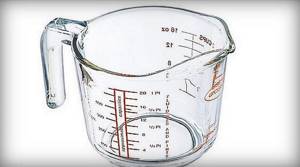
Bulk products
Approximately: 1 cup = 240 ml , or 16 tablespoons. There are 15 ml in 1 tablespoon.
- granulated sugar – 200 g
- powdered sugar – 225 g
- sifted white flour – 125 g
- white rice, uncooked – 185 g
- white rice, cooked – 175 g
- vegetable oil – 224 g
- milk – 245 g
- powdered milk – 68 g
- broccoli – 71 g
- raisins – 165 g
- cocoa powder – 128 g
- yogurt – 245 g
- water – 236 g
The volume of non-liquid ingredients specified in American recipes (if it is more than 2 tablespoons or 1 fluid ounce) is calculated using the following table.
| Ingredient weights in grams | |||||||
| Ingredient | 1 cup | 3/4 cup | 2/3 cup | 1/2 cup | 1/3 cup | 1/4 cup | 2 tbsp. |
| Wheat flour | 120 gr | 90 gr | 80 gr | 60 gr | 40 gr | 30 gr | 15 g |
| Sifted wheat flour | 110 gr | 80 gr | 70 gr | 55 gr | 35 gr | 27 g | 13 g |
| Granulated sugar (cane) | 200 gr | 150 gr | 130 gr | 100 gr | 65 gr | 50 gr | 25 gr |
| Confectionery sugar (cane) | 100 gr | 75 gr | 70 gr | 50 gr | 35 gr | 25 gr | 13 g |
| Brown sugar | 180 gr | 135 gr | 120 gr | 90 gr | 60 gr | 45 gr | 23 g |
| Corn flour | 160 gr | 120 gr | 100 gr | 80 gr | 50 gr | 40 gr | 20 gr |
| Corn starch | 120 gr | 90 gr | 80 gr | 60 gr | 40 gr | 30 gr | 15 g |
| Raw oatmeal | 90 gr | 65 gr | 60 gr | 45 gr | 30 gr | 22 gr | 11 g |
| Salt (table) | 300 gr | 230 gr | 200 gr | 150 gr | 100 gr | 75 gr | 40 gr |
| Oil | 240 gr | 180 gr | 160 gr | 120 gr | 80 gr | 60 gr | 30 gr |
| Chopped fruit | 150 gr | 110 gr | 100 gr | 75 gr | 50 gr | 40 gr | 20 gr |
| Nuts (chopped) | 150 gr | 110 gr | 100 gr | 75 gr | 50 gr | 40 gr | 20 gr |
| Nuts (crushed) | 120 gr | 90 gr | 80 gr | 60 gr | 40 gr | 30 gr | 15 g |
| Bread crumbs (fresh) | 60 gr | 45 gr | 40 gr | 30 gr | 20 gr | 15 g | 8 g |
| Bread crumbs (dry) | 150 gr | 110 gr | 100 gr | 75 gr | 50 gr | 40 gr | 20 gr |
| Parmesan cheese (grated) | 90 gr | 65 gr | 60 gr | 45 gr | 30 gr | 22 gr | 11 g |
Liquids in cooking recipes are usually measured by volume. Bulk and dry products in the metric system, on the contrary, are measured by mass.
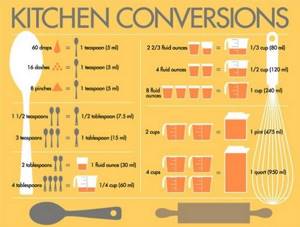
Liquid products
The following table shows the weight of liquid foods in an American cup:
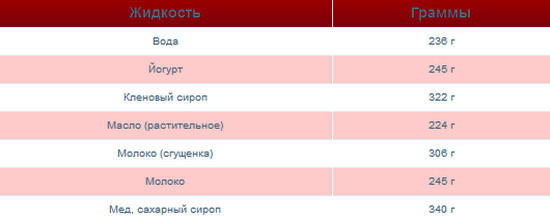
American system of measures for liquids converted to liters and milliliters:
Gallon (gal), gallon - 4 quarts - 3.8 liters Quart (qt), quart - 2 pints - 0.94 liters Pint (pt), pint - 0.47 liters Ounce (oz), ounce - 29.6 milliliters
British Imperial System of Measures for Liquids Fluid (liquid) ounces (fl oz) = 28.4 ml British quart (quart, qt) = 1.140 l = 2 pints = 4 cups British pint (pt) = 0.570 l = 2 cups British gallon (gallon, gal) = 4.54 l = 4 quarts
For ease of conversion, the value of 1 fluid ounce has been rounded to the nearest 300ml. For more accurate calculations, use the formula 1 Huid oz = 28.4 ml (English system) or 1 Huid oz = 29.5 ml (American system).
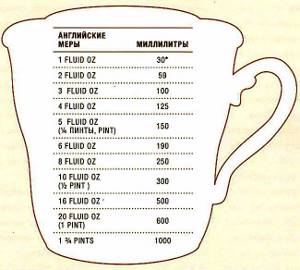
American system of measures for liquids Liquid gallon (gal), fluid gallon = 4 quarts or 3.8 liters Liquid quart (qt), fluid quart = 2 pints = 0.94 liters Fluid pint (pt), fluid pint = 0, 47 liters Fluid ounce (oz), fluid ounce = 29.6 milliliters
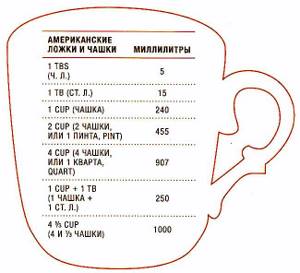
Other weights
In modern British cookbooks, it is no longer even cups that are used (cups today are marked only for cider and ale), but pounds, ounces and pints.. You may have noticed the abbreviation lb - pound .
Pound (lb, lbs), pound, avoirdupois pound - American, English pound - 454 grams 1 pound - 16 ounces.
- 1 ounce (ounce, oz) – 28.34 grams
- 1 fluid oz – 29.57 ml
- 1 gram – 0.035 ounces
- 1 pound (lb) – 0.454 kg
- 1 kg - 2.2 lbs
Weight conversion table
- 1 ounce - 28 grams
- 4 ounces - 1/4 pound - 113 grams
- 1/3 pound - 150 grams
- 8 ounces - 1/2 pound - 230 grams
- 2/3 lb - 300 grams
- 12 oz - 3/4 lb - 340 grams
- 1 pound - 16 ounces - 450 grams
- 2 pounds - 900 grams
American system of mass units Dry quart (qt), liquid quart = 1.1 liters. Dry pint (pt), dry pint = 0.55 liters.
Abbreviations and English names
1 tbs = teaspoon = teaspoon - 5 ml
1 Tb = = tablespoon = tablespoon - 15 ml
2 cups = 2 cups or 1 pint
4 cups (4 cups or 1 quart)
Teaspoon The volume of a teaspoon is different in different measurement systems. Initially, one teaspoon was a quarter of a tablespoon, then - one third. It is the latter volume that is now used in the American measurement system. This is approximately 4.93 milliliters. In American dietetics, the size of a teaspoon is 5 milliliters. In the UK it is common to use 5.9 millilitres, but some diet guides and cookbooks use 5 millilitres. The size of a teaspoon used in cooking is usually standardized in each country, but different sizes of spoons are used for food.
Tablespoon The volume of a tablespoon also varies depending on the geographic region. So, for example, in America, one tablespoon is three teaspoons, half an ounce, approximately 14.7 milliliters, or 1/16 of an American cup. Tablespoons in the UK, Canada, Japan, South Africa and New Zealand also contain three teaspoons. So, a metric tablespoon is 15 milliliters. A British tablespoon is 17.7 milliliters, if a teaspoon is 5.9, and 15 if a teaspoon is 5 milliliters. Australian tablespoon - ⅔ ounce, 4 teaspoons, or 20 milliliters.
Matches:
1 stick = 113.5 g = 1/4 lb = 4 ounces = 1/2 cup = 8 tablespoons = 14 teaspoons
1 stick = 113.5 g = 1/4 lb = 4 oz = 1/2 cup = 8 tablespoons = 14 teaspoons
British volume measures are 20% larger than American ones.
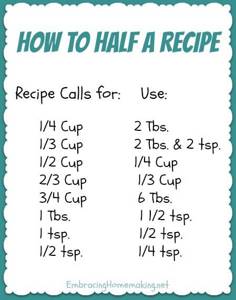
The following table provides data for converting liquid volumes
| Volume conversion (data in table is valid for liquids only) | |
| Specified quantity | Metric equivalent |
| 1 teaspoon | 5 ml |
| 1 tablespoon or 1/2 fl oz | 15 ml |
| 1 fl oz or 1/8 cup | 30 ml |
| 1/4 cup or 2 fl oz | 60 ml |
| 1/3 cup | 80 ml |
| 1/2 cup or 4 fl oz | 120 ml |
| 2/3 cup | 160 ml |
| 3/4 cup or 6 fl oz | 180 ml |
| 1 cup or 8 fluid ounces or half a pint | 240 ml |
| 1 1/2 cups or 12 fl oz | 350 ml |
| 2 cups or 1 pint or 16 fl oz | 475 ml |
| 3 cups or 1 1/2 pints | 700 ml |
| 4 cups or 2 pints or 1 quart | 950 ml |
| 4 quarts or 1 gallon | 3.8 l |
| Note: In cases where there is no need for high data accuracy, you can round the values as follows. 1 cup = 250 ml 1 pint = 500 ml 1 quart = 1 L 1 gallon = 4 L | |
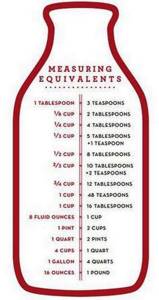
Quarts and Gallons Gallons and quarts also have different sizes, depending on the geographic region where they are used. In the Imperial system of measurement, one gallon is equal to 4.55 liters, and in the American system of measurements - 3.79 liters. Fuel is generally measured in gallons. A quart is equal to a quarter of a gallon and, accordingly, 1.1 liters in the American system, and approximately 1.14 liters in the Imperial system.
Pints are used to measure beer even in countries where the pint is not used to measure other liquids. In the UK, milk and cider are measured in pints. A pint is equal to one-eighth of a gallon. Some other countries in the Commonwealth of Nations and Europe also use pints, but since they depend on the definition of a gallon, and a gallon has a different volume depending on the country, pints are also not the same everywhere. An imperial pint is approximately 568.2 milliliters, and an American pint is 473.2 milliliters.
8 fluid ounces or 235 milliliters liquid cream tube
Fluid ounce An imperial ounce is approximately equal to 0.96 US ounces. Thus, an imperial ounce contains approximately 28.4 milliliters, and an American ounce contains 29.6 milliliters. One US ounce is also approximately equal to six teaspoons, two tablespoons, and one eighth cup.
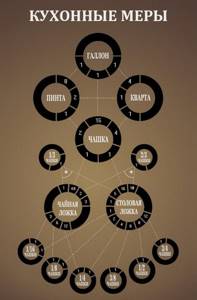
The most accurate recipes are those where ingredients are measured in grams, pounds or ounces. Because different foods have different weights when measured in cups or spoons. However, you can try to describe the most basic ones.
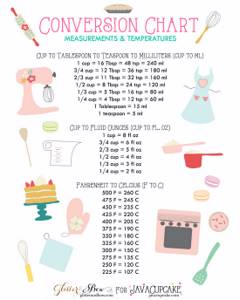
| American spoons and cups | Grams |
| 1 tbs (teaspoon) | 5 |
| 1 Tb (tablespoon) | 15 |
| 1 cup | 227 |
| 2 cups (2 cups or 1 pint) | 454 |
| 4 cups (4 cups or 1 quart) | 907 |
| 6 2/3 Tb (6 and 2/3 tablespoons) | 100 |
| 1 cup + 1 Tb (1 cup + 1 tablespoon) | 250 |
| 4 1/3 cups (4 and 1/3 cups) | 1 liter |
| What do we translate where? | Unit measurements | Qty |
| ounces to grams | ounces | 28,35 |
| grams to ounces | grams | 0,035 |
| liters to quarts | liter | 0,95 |
| quatras to liters | quatras | 1,057 |
| inches to centimeters | inches | 2,54 |
| centimeters to inches | cm | 0,35 |
| Cups | Milliliters | Cups | Milliliters |
| 1/4 | 56 | 1+1/4 | 283 |
| 1/3 | 75 | 1+1/3 | 300 |
| 1/2 | 113 | 1+1/2 | 340 |
| 2/3 | 150 | 1+2/3 | 375 |
| 3/4 | 168 | 1+3/4 | 400 |
| 1 | 227 | 2 | 450 |
With this table you can convert ounces to grams. But keep in mind that the ounces in this table are different from those in the table for liquid products.
| Weight conversion | |
| Specified quantity | Metric equivalent |
| 1 oz | 28 g |
| 4 oz or 1/4 lb | 113 g |
| 1/3 lb | 150 gr |
| 8 ounces or 1/2 pound | 230 gr |
| 2/3 lb | 300 gr |
| 12 oz or 3/4 lb | 340 gr |
| 1 pound or 16 ounces | 450 gr |
| 2 pounds | 900 gr |
| Grams | Ounces |
| 25 | 0,87 |
| 30 | 1,00 |
| 50 | 1,75 |
| 75 | 2,63 |
| 80 | 2,80 |
| 85 | 3,00 |
| 100 | 3,50 |
| 125 | 4,40 |
| 150 | 5,25 |
Oil
Americans sell butter not in packs, but in sticks. American butter stick weighs
113 grams, that is 4 ounces.
1 cup butter = 2 sticks = 8 oz = 227 g
1/4 cup butter = 55 g 1/3 cup butter = 75 g 1/2 cup butter = 115 g
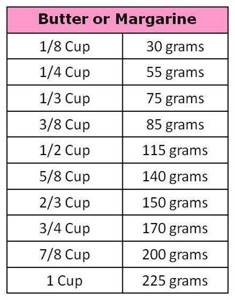
High-grade flour of Ukrainian or Russian production
1 cup = 5 ounces = 144 g
1/2 cup = 2.5 ounces = 72 g
1/3 cup = 1.7 oz = 48 g
1/4 cup = 1.27 oz = 36 g
1/8 cup = 2 tablespoons = 0.63 ounces = 18 g
Important point! A cup of sifted flour will be approximately 8-10g lighter, measuring 134-136g
Inconsistency
Another important point. Americans estimate the weight of a cup of flour to be 128 g. Our product is heavier. Moreover, I weighed both regular, premium flour and superfine flour. That is, when baking according to American recipes, it is worth taking a spoonful of flour from our cup somewhere so that the weight matches.
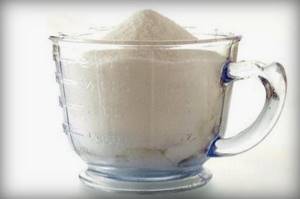
Granulated sugar of Ukrainian or Russian production
1 cup = 6.9 oz = 195 g
1/2 cup = 3.5 ounces = 98 g
1/3 cup = 2.3 ounces = 65 g
1/4 cup = 1.7 oz = 49 g
Syrups and honey
Thick syrups and honey are significantly heavier than water, which will affect their weight when measured in cups
Useful information:
Pud (pood) is an old Russian unit of measurement. 1 pood = 40 Russian pounds or 16.38 kg.
Table of fat percentage in cream
| Cream | |
| Cream type | Fat content |
| Jersey (English version) | 60% |
| Double (English version) | 48% |
| Heavy (American version) | 40% |
| Whipping | 30-60% |
| Single (English) or Light or Table (American) | 18% |
| Half and Half (American version) | 10-18% |
| Half Cream (English version) | 12% |
Converting Fahrenheit temperature to Celsius temperature:
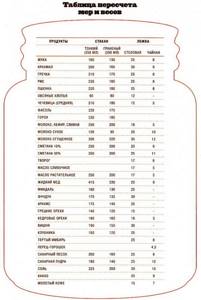
Based on materials from fanilla.ru, sweetmenu.ru, www.translatorscafe.com, etc.
To be honest, I'm a little confused with the American and English systems of measurements in cooking. The more I look for information, the less clear it becomes to me. The further into the forest, the more firewood.
Source
Bulk solids measurement
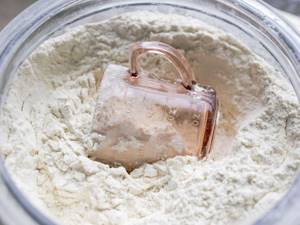
When preparing porridges, baked goods and other dishes, it is often necessary to measure bulk products with a glass.
In a recipe, for example, you see: “Take half a cup of cornmeal.” But there is no explanation anywhere, 1/2 cup - how much will it be in grams? If you have a scale, you can determine the volume of your glass and then measure out the dry goods based on the weight. In the same case, if you do not have scales, then there are special tables to determine the weight and volume of bulk ingredients, as well as their compliance with measuring containers. From them you can easily determine how much it is - 1/2 cup. Weight of bulk components
| The product's name | Product weight in 1/2 cup |
| Wheat flour, unsifted | 90 g |
| Sifted wheat flour | 75 g |
| Sand sugar | 100 g |
| Powdered sugar | 60 g |
| Dry peas | 115 g |
| Rice | 110 g |
| Buckwheat | 105 g |
| Semolina | 100 g |
| Cereals | 30 g |
How to measure the required amount with a glass?
If you need to measure the required volume, then everything is simple. The volume of a faceted glass to the rim is 200 ml, to the brim - 250 ml.
But if you need to find out the weight, then difficulties may arise. For example, a glass of milk or water will be 200 g. If the recipe refers to the weight of flour, sugar or other bulk ingredients, then it will be different.
In order to navigate the volumes, the housewives used a special reminder.
Here are a few main points:
- flour – 130 g;
- sugar – 180 g;
- powdered sugar – 160 g;
- sour cream – 210 g;
- condensed milk – 360 g;
- rice – 180 g.
Converting US measures to grams
American measuring cup
1/4 cup - 60ml 1/3 cup - 75ml 1/2 cup - 125ml 2/3 cup - 150ml 3/4 cup - 175ml 1 cup - 250ml
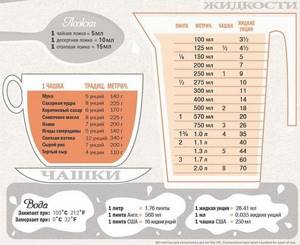
1 cup white flour 140 g 1 cup sifted white flour 115 g 1 cup cake flour 130 g 1 cup sifted cake flour 100 g 1 cup whole wheat flour 150 g 1 cup sifted whole wheat flour 130 g 1 cup bread flour 160 g 1 cup sifted bread flour 130g 1 cup sugar 200g 1/2 cup potato flakes 35g 1 cup self-raising flour - 120g 1 cup chickpea flour - 90g 1 cup tempura flour - 125g 1 cup soy flour - 135g 1 cup brown sugar – 180 g 1 cup pine nuts – 130 g 1 cup walnuts – 114 g 1 cup cashews, toasted – 150 g 1 cup almonds, toasted, coarsely chopped/ground – 120 / 180 g 1 cup sesame seeds – 150 g 1 cup pumpkin coarsely grated – 125g 1 cup coarsely grated zucchini – 135g 1 cup Parmesan, grated – 120g 1 cup breadcrumbs – 120g 1 cup fresh bread crumbs – 90g 1 cup Panko breading – 60g 1 cup couscous - 185 g 1 cup raisins - 200 g 1 cup water chestnuts, chopped - 180 g 1 cup cabbage, chopped - 75 g 1 cup Chinese or Savoy cabbage, chopped - 45 g 1 cup fresh coriander (cilantro), coarsely chopped / chopped – 30 / 60 g 1 cup of green peas – 160 g 1 cup of coconut flakes – 60 g 1 cup of baby spinach (leaves) – 50 g 1 cup of black currants – 120 g 1 cup of dried crushed dates – 180 g 1 cup of dry chickpeas - 220 g In America, butter is sold not in packs, but in sticks. An American stick of butter weighs 113 grams, which is 4 ounces.
